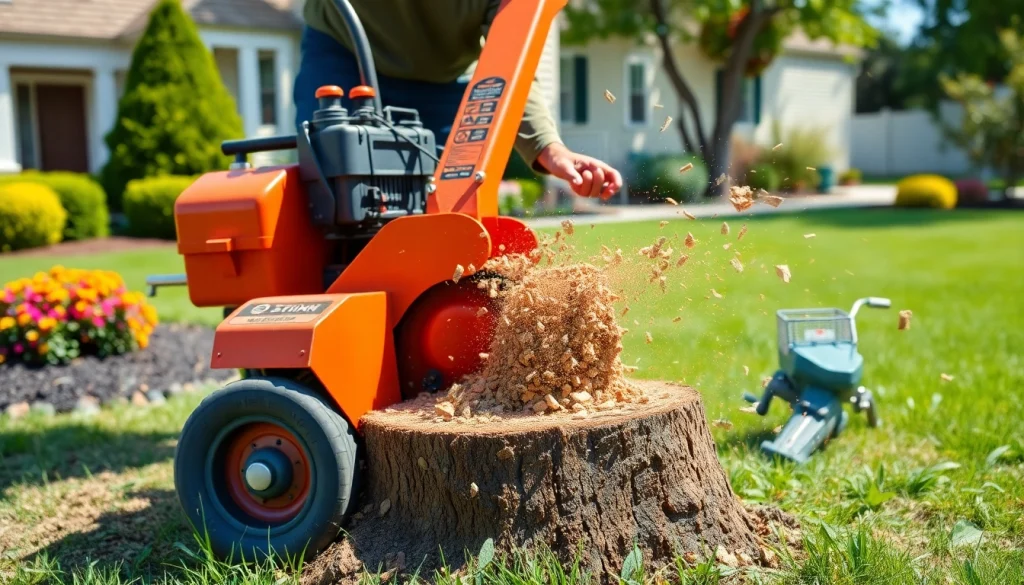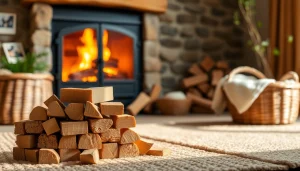Essential Stump Grinding Service: What You Need to Know for Tree Care

Understanding Stump Grinding Services
Stump grinding is a specialized service aimed at effectively removing tree stumps left behind after tree cutting. This process not only enhances the aesthetic appeal of your landscape but also prevents potential hazards and paves the way for future planting endeavors. Engaging a reliable stump grinding service can drastically reduce your workload while ensuring that the job is done correctly.
What Is Stump Grinding?
Stump grinding involves the removal of a tree stump utilizing a heavy-duty piece of machinery known as a stump grinder. This machine grinds the stump down into smaller wood chips, which can seamlessly blend into your landscape. The grinder operates by using a circular blade embedded with sharp, heavy-duty teeth that shred the stump into mulch, which can be used as ground cover or compost.
The Benefits of Professional Stump Grinding
Choosing to hire professionals for stump grinding comes with several distinct advantages:
- Safety: Tree stumps can pose significant hazards in yards, particularly for children and pets. By grinding the stump, you eliminate tripping risks.
- Efficiency: Professional services come equipped with powerful machinery and expertise, enabling swift stump removal.
- Aesthetic Improvement: Stump grinding can significantly enhance the visual appeal of your landscape, allowing for a clean and tidy area.
- Soil Health: The ground stump can be left as mulch, improving soil quality and health over time.
- Future Planting: Removing stumps gives you the opportunity to replant in the area and develop diverse landscaping options.
How Stump Grinding Works: A Step-by-Step Guide
The process of stump grinding is relatively straightforward. Here’s how it works:
- Initial Assessment: A professional will assess the site to determine the best approach for stump removal.
- Preparation: The area around the stump is cleared of any obstacles, such as rocks or debris.
- Grinding: The stump grinder is positioned over the stump, and the grinding process begins. The machine is often lowered into the stump, and the grinder blade starts to chip away at the wood.
- Depth Control: The grinder is moved down or adjusted to ensure that the stump is ground down to the appropriate level, usually 4-6 inches below ground level.
- Cleanup: The wood chips can either be removed or left on-site for use as mulch.
Choosing the Right Stump Grinding Service
Hiring the right stump grinding service is crucial for ensuring a satisfactory outcome. Below are essential factors to keep in mind when making your choice.
Factors to Consider When Hiring a Stump Grinding Service
When assessing potential stump grinding companies, consider the following:
- Experience: Look for companies that have a solid track record in stump grinding and tree care. Experience often correlates with a higher level of service.
- Equipment: Ensure that the company possesses modern and well-maintained equipment to handle your job efficiently.
- Insurance: A reputable service should carry liability insurance to protect against accidents or damages that could occur during the grinding process.
- Reviews: Check customer reviews and testimonials for insights into the quality of service you can expect.
- Quote Transparency: The company should provide a clear estimate of costs with no hidden fees.
Questions to Ask Your Stump Grinding Professionals
Asking the right questions can unveil critical details about the service. Here are the top questions to consider:
- What methods do you use for stump grinding?
- How deep will you grind down the stump?
- How long will the job take?
- Do you remove the wood chips after grinding?
- Can you provide references from previous clients?
Comparing Stump Grinding Services: Cost and Value
The cost of stump grinding can vary based on several factors, including location, stump size, and complexity of the job. On average, homeowners can expect to pay between $60 and $350 per stump. It’s essential to weigh cost against value by considering quality, service guarantees, and additional benefits provided by the company. Sometimes, paying a little extra for a service that offers comprehensive care and equipment can be more beneficial in the long run.
DIY vs. Professional Stump Grinding
Deciding between DIY stump grinding and hiring professionals is a common dilemma among homeowners, often hinging on budget, experience, and desired results.
Pros and Cons of DIY Stump Grinding
Pros:
- Cost Savings: Handling the job yourself can save you money.
- Control: You can manage the pace and method of the grinding to fit your preferences.
- Learning Opportunity: It can be an educational experience if you’re looking to learn more about landscaping work.
Cons:
- Safety Risks: Stump grinding equipment can be dangerous without proper training.
- Time-Consuming: The process can take longer without experience and specialized equipment.
- Potential for Damage: Improper grinding can damage surrounding areas or underground utility lines.
When to Hire a Stump Grinding Service Instead
Opt for a professional service when:
- The stump is large or deeply rooted.
- You lack familiarity with landscaping tools or safety protocols.
- You have limited time to manage the project.
- There are potential hazards near the stump, like power lines or structures.
- You require a clean finish and possibly additional landscaping help afterward.
Tools and Equipment Needed for DIY Stump Grinding
If you choose to go the DIY route, here’s a list of tools you’ll need:
- Stump Grinder: Available for rent or purchase; be sure to choose one appropriate for the size of your stump.
- Protective Gear: Safety goggles, gloves, and ear protection are essential.
- Shovel: Useful for clearing dirt and debris around the stump.
- Chainsaw: Handy for cutting down larger stumps before grinding.
- Rake: For gathering debris and wood chips after the grinding is completed.
Maintaining Your Landscape After Stump Grinding
Once the stump is ground away, your landscape may need some extra attention to ensure it remains beautiful and functional.
Best Practices for Replanting in the Area
After stump grinding, it’s important to consider what to plant next. Some best practices include:
- Wait at least a month before replanting to allow the ground to settle.
- Choose plants that are suited for the region and soil conditions.
- Ensure that there is proper drainage to avoid waterlogging around newly planted roots.
Filling the Hole: Options and Techniques
The hole left after stump grinding needs to be filled properly to avoid issues like erosion. Here are some options:
- Topsoil: Fill the hole with topsoil, and you can sow grass seeds or plant flowers to enhance your yard.
- Wood Chips: Recycle the wood chips generated from grinding, though it’s advisable to mix them with topsoil as they can absorb nitrogen.
- Compost: Incorporating compost aids in enriching the soil while filling the hole.
Long-Term Care of Your Newly Landscaped Yard
To ensure your landscape thrives, engage in the following maintenance practices:
- Water newly planted flora consistently, especially in the initial months.
- Monitor for pests and diseases regularly to intervene early.
- Mulch the area to retain moisture and suppress weed growth.
Environmental Impact of Stump Grinding Services
Stump grinding can provide a significant positive environmental impact when conducted responsibly.
How Stump Grinding Promotes Environmental Health
Stump grinding supports environmental health by:
- Reducing Landfill Waste: Instead of disposing of a stump in a landfill, grinding transforms it into reusable mulch.
- Promoting Biodiversity: A clear area post-stump grinding allows for diverse planting, improving local biodiversity.
Considerations for Wildlife and Soil Health
Stump grinding affects soil health and wildlife in various ways, including:
- Improving soil quality by returning organic matter into the ecosystem.
- Providing mulch that protects soil moisture levels, benefiting critters and plants alike.
Finding Eco-Friendly Stump Grinding Services
To select an environmentally responsible stump grinding service, consider these steps:
- Ask if they recycle or repurpose wood chips and other materials.
- Inquire about their adherence to sustainable practices during stump grinding operations.
- Look for certifications or memberships in tree care organizations focused on sustainability.






